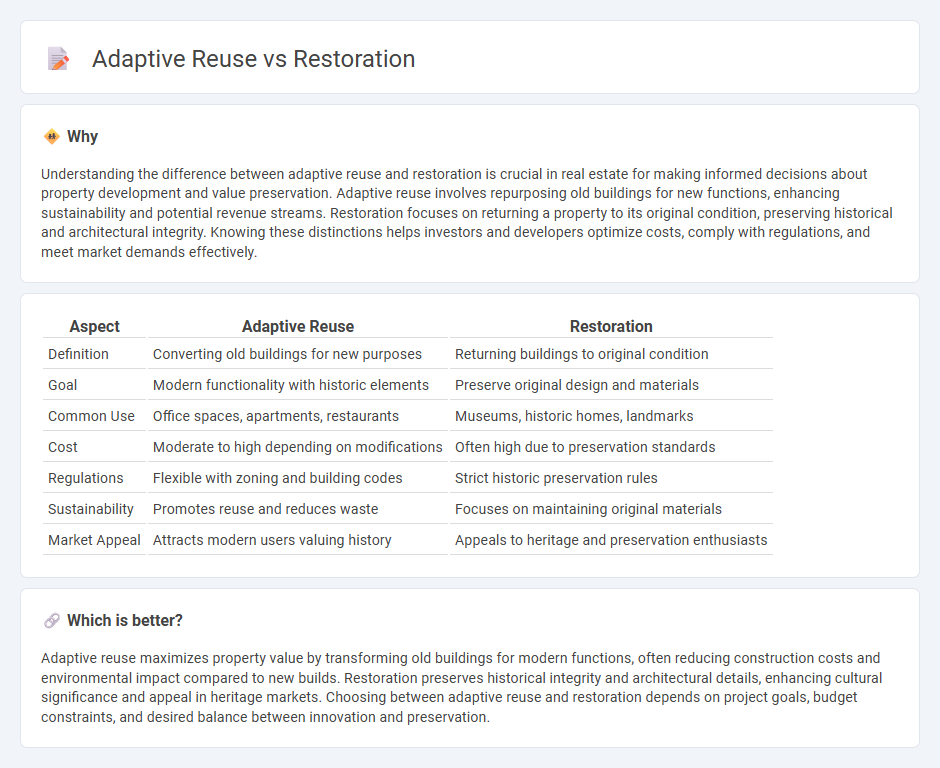
Adaptive reuse transforms existing buildings by repurposing them for new functions, enhancing sustainability and preserving architectural character. Restoration involves returning a property to its original state, emphasizing historical accuracy and cultural significance. Explore the key benefits and challenges of adaptive reuse versus restoration in real estate projects to make informed decisions.
Why it is important
Understanding the difference between adaptive reuse and restoration is crucial in real estate for making informed decisions about property development and value preservation. Adaptive reuse involves repurposing old buildings for new functions, enhancing sustainability and potential revenue streams. Restoration focuses on returning a property to its original condition, preserving historical and architectural integrity. Knowing these distinctions helps investors and developers optimize costs, comply with regulations, and meet market demands effectively.
Comparison Table
| Aspect | Adaptive Reuse | Restoration |
|---|---|---|
| Definition | Converting old buildings for new purposes | Returning buildings to original condition |
| Goal | Modern functionality with historic elements | Preserve original design and materials |
| Common Use | Office spaces, apartments, restaurants | Museums, historic homes, landmarks |
| Cost | Moderate to high depending on modifications | Often high due to preservation standards |
| Regulations | Flexible with zoning and building codes | Strict historic preservation rules |
| Sustainability | Promotes reuse and reduces waste | Focuses on maintaining original materials |
| Market Appeal | Attracts modern users valuing history | Appeals to heritage and preservation enthusiasts |
Which is better?
Adaptive reuse maximizes property value by transforming old buildings for modern functions, often reducing construction costs and environmental impact compared to new builds. Restoration preserves historical integrity and architectural details, enhancing cultural significance and appeal in heritage markets. Choosing between adaptive reuse and restoration depends on project goals, budget constraints, and desired balance between innovation and preservation.
Connection
Adaptive reuse and restoration in real estate both focus on preserving the historical and architectural integrity of existing structures while giving them new functionality and modern relevance. Restoration aims to maintain or return a building to its original condition, ensuring historical authenticity, whereas adaptive reuse repurposes the structure to meet current market demands, such as converting old factories into residential lofts or office spaces. These practices collectively contribute to sustainable development, urban revitalization, and the conservation of cultural heritage within real estate projects.
Key Terms
Historic Preservation
Restoration involves returning a historic building to its original condition by repairing or replacing deteriorated elements, preserving architectural authenticity and heritage value. Adaptive reuse transforms historic structures for new purposes, balancing preservation with modern functionality to extend a building's lifespan while retaining significant features. Explore detailed strategies and case studies to better understand these essential historic preservation approaches.
Building Function
Restoration preserves a building's original function and architectural integrity, maintaining historical use and design while repairing damage and deterioration. Adaptive reuse transforms a building's purpose, repurposing it for new functions that meet contemporary needs, often enhancing sustainability by reducing demolition waste. Explore detailed comparisons to understand which approach suits your project goals best.
Zoning Compliance
Restoration involves returning a building to its original state, often requiring strict adherence to historic zoning regulations that preserve architectural integrity. Adaptive reuse modifies existing structures for new purposes, balancing zoning compliance with functional upgrades and modern codes. Explore the nuances of zoning compliance in restoration and adaptive reuse to optimize your project outcomes.
Source and External Links
restoration - Wiktionary, the free dictionary - The process of bringing an object or entity back to its original state, including the undoing of modifications or damages.
RESTORATION Definition & Meaning - Dictionary.com - The act of restoring or renewal; a return of something to its original or unimpaired condition.
Restoration - Wikipedia - The act of restoring something to its original state, referring to cultural property conservation, ecological restoration, and historically significant political periods named "Restoration."
 dowidth.com
dowidth.com